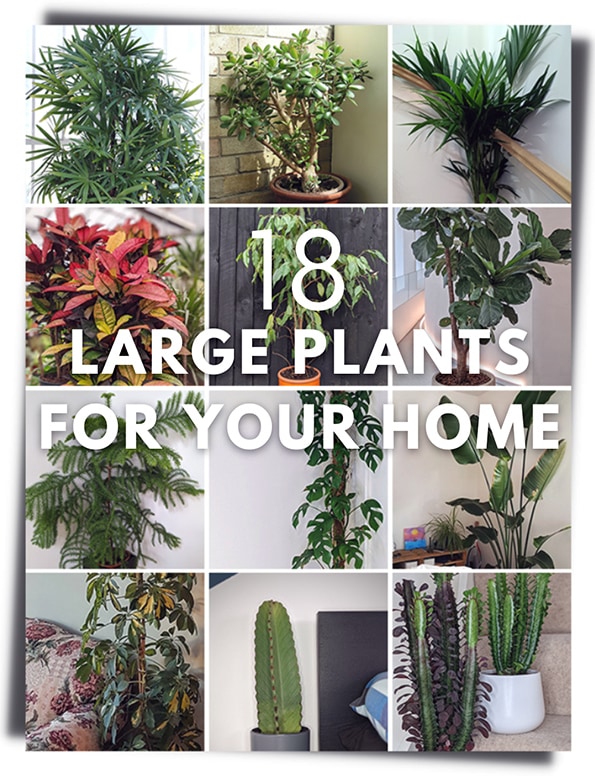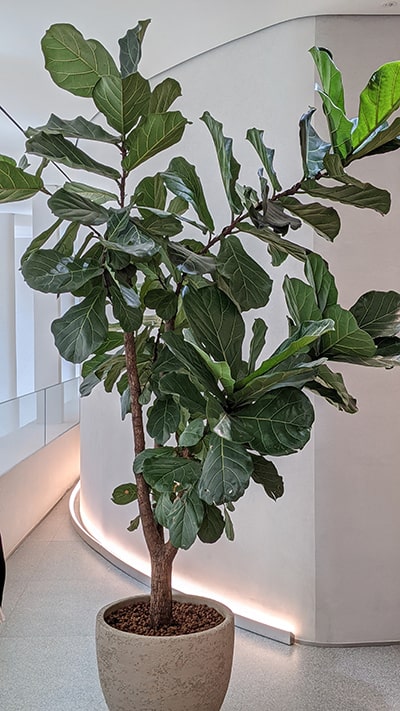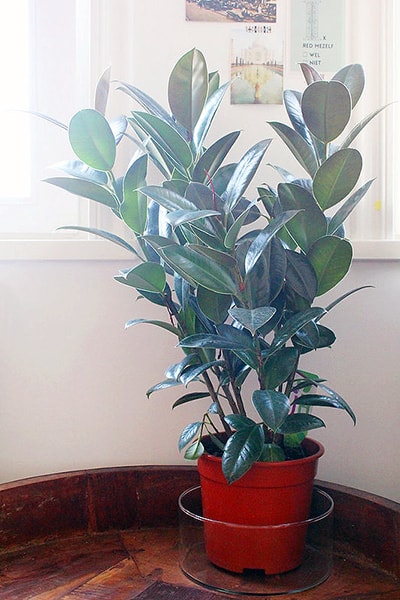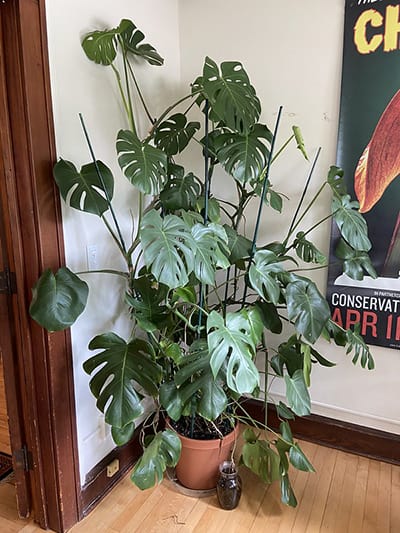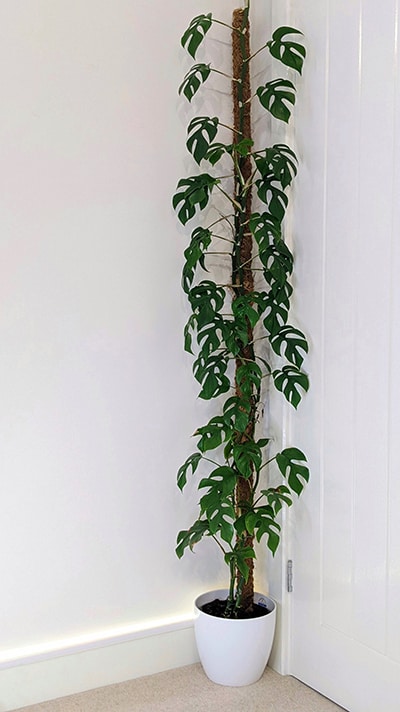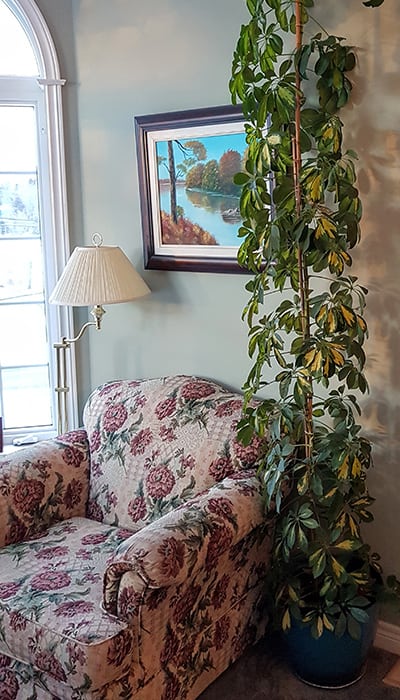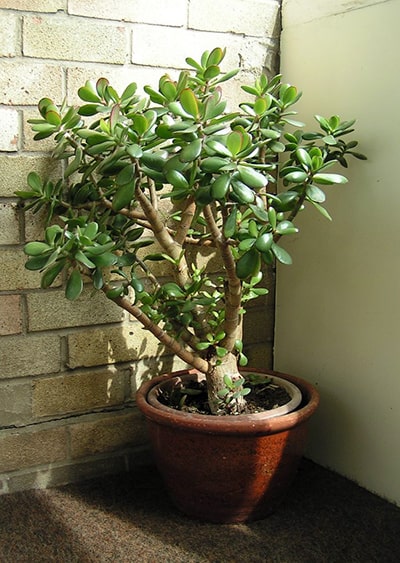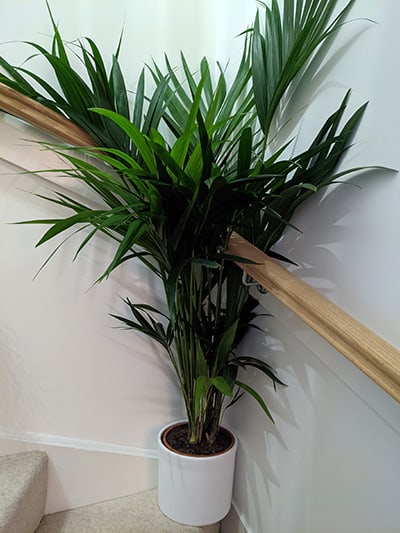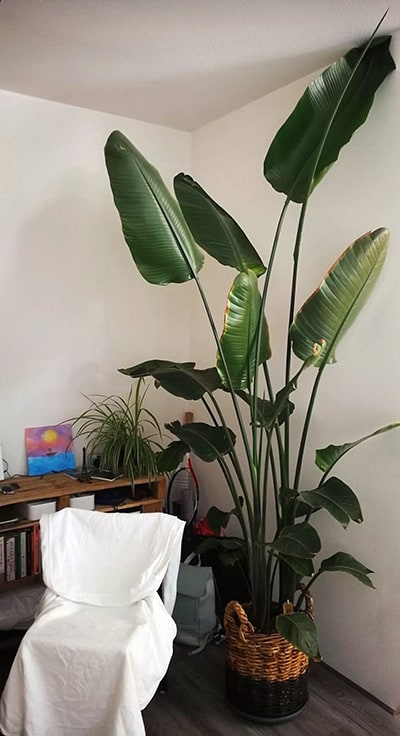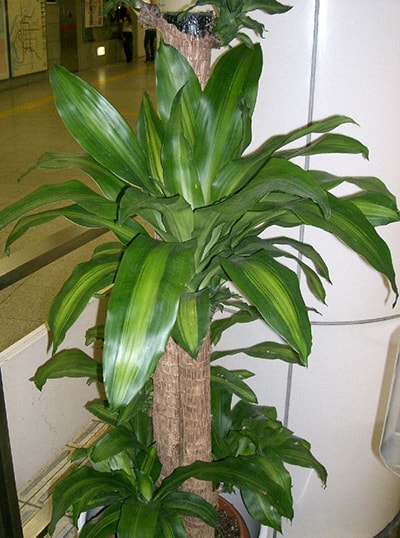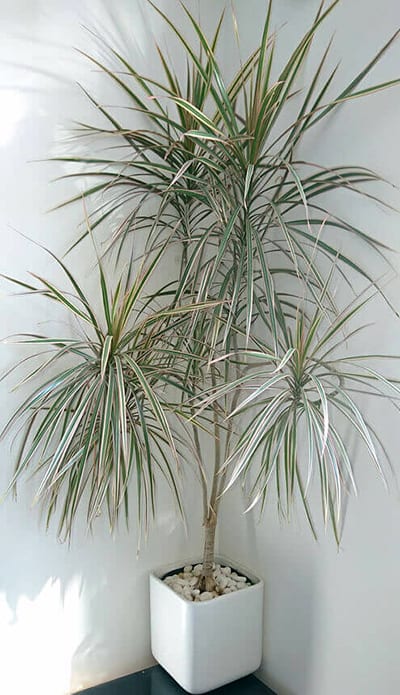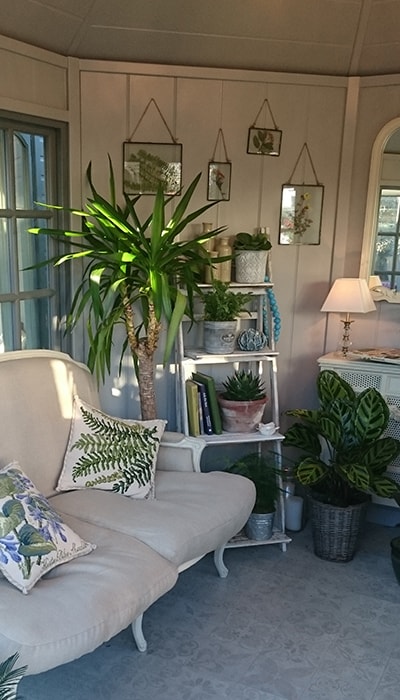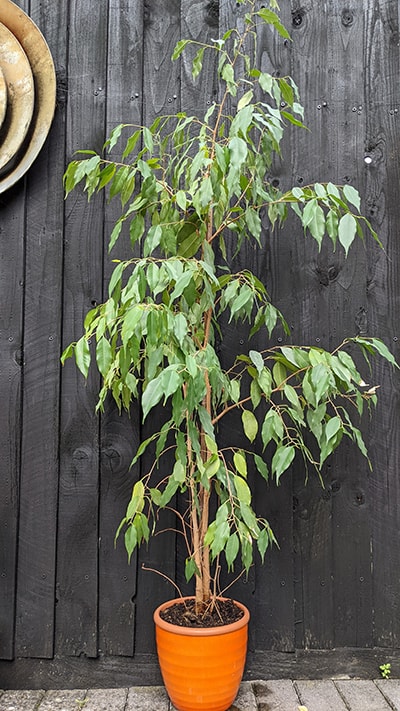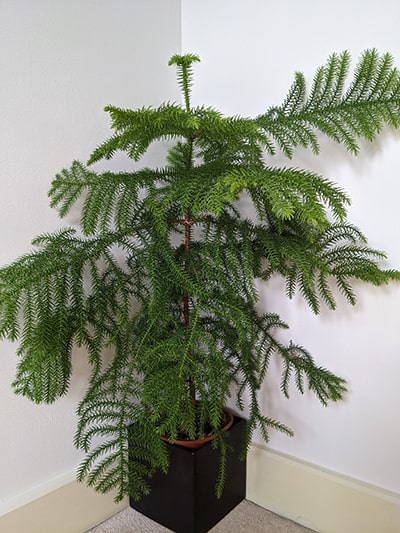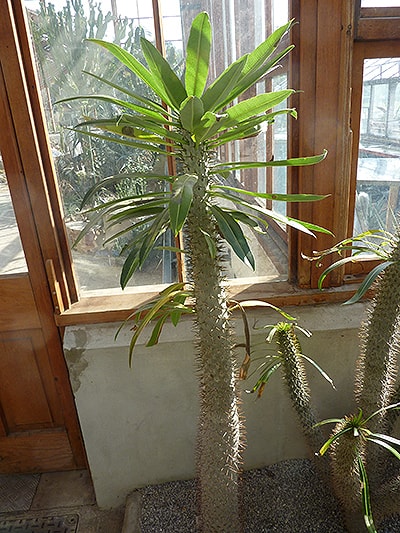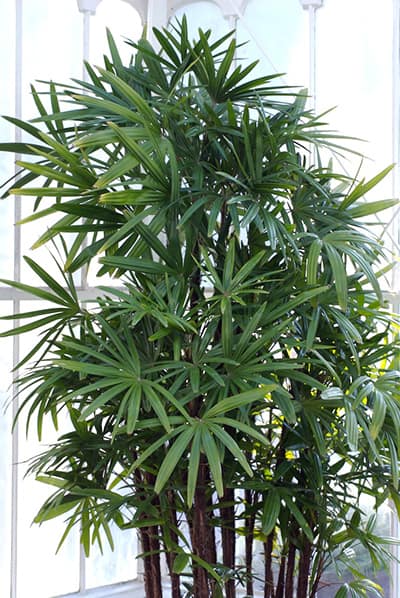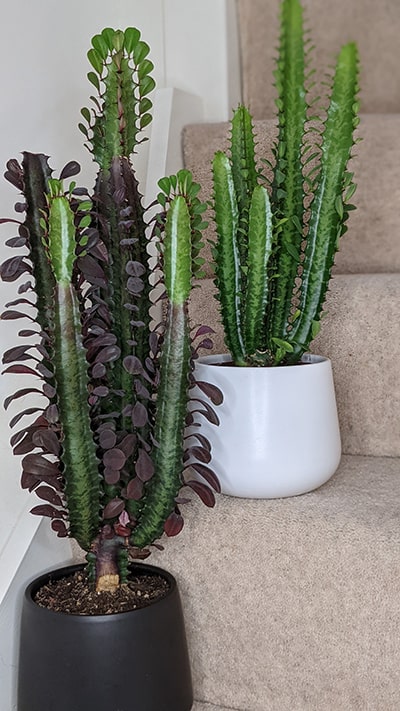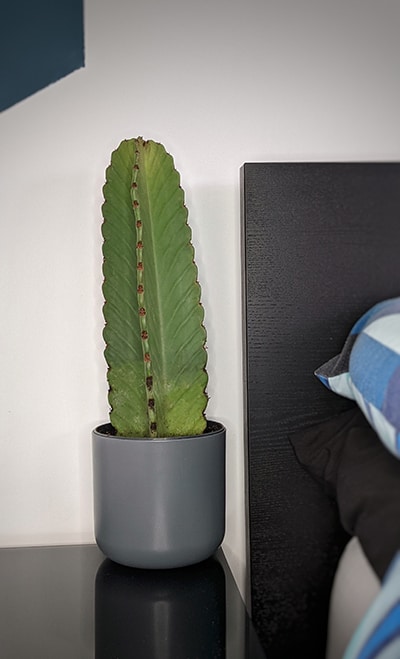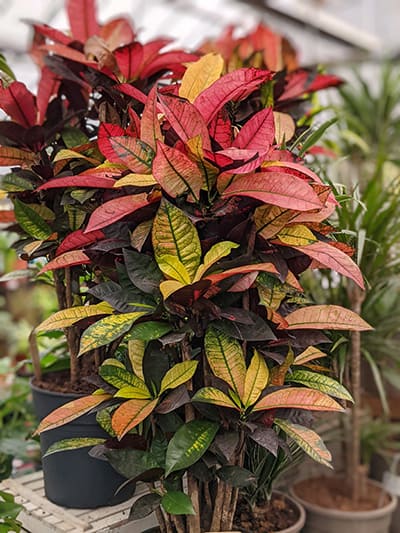Lots of small houseplants clustered together can look really great, especially for collectors trying to create a lush indoor jungle. But sometimes, all you want is just one or two large indoor plants in your home and that's cool too.
And here's why.
Large plants can be imposing and dominate a space, but in a good way. These are known as statement plants or specimen plants.
You don't need many, perhaps just one or two to complete a room or living area. They can show off your personality and become visitor talking points, giving a little taste of an indoor jungle, but with minimal ongoing effort.
This guide has 18 tall plants I recommend for anyone with big indoor spaces that need filling.
Below are my favorite large houseplants that are pretty easy going, and over time, will reach for the stars (or your ceiling), becoming proper characters and a part of the furniture as they grow bigger and bigger.
Top Tip
Big plants can be expensive to buy. It might be worth being cautious if you struggle to keep simple houseplants alive like a Snake Plant or Parlor Palm. Opt for young plants on this list so you gain experience without the risk of getting it wrong and wasting your money.
My list has a wide variety, from tall, wide and somewhere in-between, as well as several that will take different light conditions. If you're looking for inspiration, there will be one plant (at least) that should make it to your shortlist.
Most listed will make for a great indoor plant, they all have fairly simple needs (some more than others), and where relevant, I'll link out to our more extensive articles for additional guidance. If you have any comments or other recommendations, let me know. Plus if you're already an owner of one of these beauties, show it off to me.

Hi, I'm Tom!
If you're like me and enjoy the challenge of growing houseplants and getting them to thrive, then Ourhouseplants can help. This website shares my knowledge and years of growing plants and provides (hopefully) helpful advice on properly caring for your indoor plant friends.
18
The Fiddle Leaf Fig is more of a modern houseplant, but it copes really well indoors providing you can give it a spot with bright light. If you can, it'll grow fast and tall. Even small plants can put on significant growth and become dominant statement plants within a few years.
The only drawback is that it has a bit of a fussy and diva nature. If you don't accommodate its needs, it will drop leaves. Fast. Fortunately for you, we have a complete care guide that will tell you everything you need to know.
This Fiddle-Leaf Fig (Ficus Lyrata) shows off its impressive height and huge fiddle-shaped leaves.
A houseplant of this size would be expensive, so it's often cheaper to buy a smaller one and grow it on to become an indoor tree. However you approach it, think of them as investment pieces, either in terms of money or your time and effort to grow them.
17
The Rubber Plant, like the Fiddle Leaf, is another Ficus that does really well indoors. In fact it's been grown in homes for decades and is still super popular today.
The all-green variety is the most traditional, but many different varieties have come to the market over the years. So there is something for every decor and design.
All you need is space. They'll grow tall fast and can also produce side shoots, so they can get a little wide. The good news is that you can prune the plant to an extent to help keep it neat and looking how you want it.
Ficus elastica, commonly known as the Rubber Plant or Rubber Tree - Photo by Deepa Paul
The Rubber Plant is very easy going, rarely drops leaves (unless overwatered) and will put up with lower light areas. No wonder its popularity has continued over such a long period.
16
Was there really any doubt that the Monstera would appear on the list? Of course not. Like the Rubber Plant above, the Swiss Cheese Plant has been a staple in homes for over 50 years and for good reason.
They're straightforward to look after. It puts up with neglect, lower light levels, and gives off a definite tropical vibe. Definitely, one of the best large indoor plants you can own.
The Infamous Monstera Deliciosa will eventually become enormous - Photo by FarOutFlora
The only negative is that they can be untidy. Give them a moss pole or support, and they'll grow upward for sure, but they also have the habit of sprawling and spreading outward, taking up a large amount of space in your room.
This type of growth habit in big spaces is no problem. If space is limited, but you love the Monstera look, check out the next plant on my list for a perfect alternative.
15
A super new houseplant that has only started to gain popularity over the last five years. It has the fenestrations, splits and unusual leaf shape of the bigger Monstera Deliciosa but in a much more compact form.
It can grow crazy fast and a small pot plant will be touching the ceiling within two years. All it needs to do this is a totem pole to climb up: bright indirect light, warmth, and regular watering. If you can do this, you'll get a plant that looks similar to the one in the photo below.
Rhaphidophora tetrasperma has the classic Monstera look, but has a very slender footprint. Hence the common name "Mini Monstera".
This is a brilliant statement plant when you have limited space. Perhaps in a small apartment or flat. They will attract eyes and be a talking point while only taking up a narrow margin in your home.
14
Another classic, the Umbrella Plant (Schefflera) looks good in both traditional and modern design. It has a reasonably slender footprint and will grow taller yearly by two feet or more if given good light.
Once they hit the roof, you can trim off the top to encourage side shoots to grow. Make sure you treat it right though, otherwise you'll lose the leaves lower down and up with more of an Umbrella Tree look.
This plant is over eight feet tall, and took about three years to get that size says Bill who sent in his photo.
With just the one architectural plant in the room, it creates a real talking point, especially as it would tower above anyone sitting in the nearby chair.
13
The Jade Plant (Crassula ovata) doesn't grow as colossal as the ones already mentioned, but it can grow wider and spread out far.
They're slow growers in comparison, but these are "forever plants". If you give them the proper care and attention, you can easily own it for 50 years or more. See our Care Guide for growing tips.
Over many years even the smallest Jade will become quite substantial. Photo by Sannse
This is a plant that would put up with some direct sun on the leaves, so don't be afraid to give them a prominent position next to a window. They're succulents, so go easy on the watering and ensure you don't overdo it as this will quickly lead to overwatering issues.
12
The first Palm on our list, the Kentia Palm is a superb choice if you want tropical plants and the vibe that comes with that in your home. It's potentially the easiest going palm I have in my home. Standing bold and strong all year round with minimal fuss.
The Kentia Palm can put up with lower light locations but will continue to look handsome and is low maintenance.
It's a fairly thirsty plant, especially if kept in a relatively small pot like the one shown in the photo. So I swing by a few times a week with my watering can and once every 6 months I'll take it outside to give it a proper wash to get rid of the dust that settles on the fronds.
Other than that it doesn't need any special care and can be left alone to do its thing.
11
The Bird of Paradise (Strelitzia Reginae) is desired because of the spectacular colorful flowers that occasionally appear. However most owners realised that their plants would rarely flower indoors (insufficient light and growing space are the typical reasons).
At the same time, a gradual shift from flowering plants to ones with attractive foliage has become an important trend over the last five or so years. No surprise then that Strelitzia Nicolai has now rivaled the Reginae species in terms of desirability for our homes.
It grows much bigger than its cousin, both in height and by way of its large leaves. Expect a genuinely immense-looking plant in five years or less.
Strelitzia Nicolai is the perfect example of an architectural houseplant and one of the tallest you can grow indoors. Photo by Laurawolf9
The Nicolai is even less likely to flower indoors because it needs serious space to get to a larger enough size before it shows off its gorgeous white flowers. Laura sent us a photo of her Bird of Paradise because it had grown so big it was now hitting her ceiling!
If you have the same problem, all you can do is just trim off the highest leaves or move the plant to somewhere with more head height.
10
The Corn Plant or Dracaena Fragrans is called a False Palm because it looks like a Palm Tree. It's not a palm, but it is definitely a bold statement houseplant.
If you get one with several canes or stems in one pot, you will have an eye-catching plant to show off in your home. Ideally, somewhere with bright indirect light is best, but they can deal with a slightly darker location is necessary.
They can make for bold looking indoor plants - Photo by KENPEI
There are lots of varieties available these days, from all green types, to ones with stripes in different colors.
You could find it flowering out of the blue with proper long-term care and after many years down the line. Check out our care guide and the comments section as the surprise blooming is a big deal with many of our readers.
9
One of my first houseplants was a Dragon Tree and I still have it in my collection today. I was also given another when I started a job in 2007 and I still have that one too. It's finally made it to the roof of the room and I know I'm going to have to prune it a little soon. You can read about my experiences with these plants over on my Dragon Tree guide.
My point though is that they have excellent longevity and don't grow as fast as some of the others in this list. This is perfect and ideal for some people. They really are beautiful and not overly expensive houseplants.
This was one of my very first houseplants. It's well over 20 years old.
They're tough plants too. The one above put up with low light for five years before I moved it somewhere brighter. They drop a fair amount of leaves in Spring and Summer before growing replacements at the top, but otherwise I've found them to be almost maintenance free. I recommend this family of plants 100%.
8
Yucca's are a brilliant pick if you want a strong tree like plant, that looks great but doesn't need any fuss and grows slowly. You don't need a green thumb to grow them, although they need very bright light or some sunshine.
Yucca's tend not to be too wide-reaching, but they still have a substantial quality about them.
The sword-like leaves can be rough to touch, have sharp edges, and some cats may use the trunk as a scratching post, ruining the ascetic.
For these reasons, it's perhaps better to try and find a home for it that is out of the way, so you may need to think if you can provide this. Otherwise, it's a great choice larger plant for most homes.
7
If you're looking for a calming and tranquil houseplant, then the Weeping Fig (Ficus Benjamina) could be the one. The main stems are fairly skinny but the numerous leaves droop a little, giving a very relaxed or "weeping" look.
It's a true foliage plant, and if that appeals to you in your design, it will be perfect for helping to soften hard lines created from square or angular furniture.
It's not normally a good idea to move them around as this can trigger leaf drop, but once a year my Weeping Fig goes outside for a wash down, as the dust accumulates on the leaves more than you think!
It's a reasonably easy popular houseplant but does have a few quirks that need to be accepted if you want to grow a happy and healthy plant. Our write up article has information about all this if needed.
6
The Norfolk Pine (Araucaria heterophylla) is a seasonal houseplant you will mainly find in stores over Christmas, mostly because it looks like a Christmas tree! However, it absolutely hates cold temperatures, although you can easily keep it growing indoors all year round and it doesn't drop "pines".
Over time the upper branches will become very broad and a little limp from their weight. They'll hold up a handful of decorations if you fancy using it as a make-shift decoration piece over the festive season, but that's it.
Norfolk pines are not the most popular large indoor plant you will find, but they certainly have charm and look very unique.
They don't like drying out completely so try and keep the soil moist where possible. If you mess up and the potting mix does dry out completely the whole plant will start to hang and wilt a little.
5
Something a little different this time. The Pachypodium or Madagascar Palm is less common than most tall houseplants on this list, but if you're a fan of its quirky appearance, it's a fascinating plant to own.
It may not necessarily be a plant you want in your living room, but if you have somewhere that gets lots of light these could be a brilliant fit.
They look like palm trees and add an exotic feel to a space that gets direct sunlight. Photo by Magnus Manske
They're not hard plants to keep, and although slow growing will eventually reach impressive heights even when grown indoors.
4
Another palm for you now. Rhapis Excelsa or the Lady Palm, is less common than the usual palms you can buy, but it's a ridiculously easy plant to own. It's a slow grower but will become a large houseplant with decent care.
In time, Lady Palms will become tall indoor trees - Photo by Eric in SF
They don't need much light to do well, and the stems underneath the foliage are unusual and add a lot of visual interest. It reminds me of a bamboo palm but with much more of a bamboo look about it. Worth checking out if you like palms but want something a little rarer.
3
Another fairly "modern" plant now. The African Milk Tree or Euphorbia Trigona, will become huge after several years.
Each stem or "branch" will frequently grow 8 inches or so each year, which might not sound a lot, but that growth is almost always directly upwards.
There are two varieties you can get. The all green type on the left or one with darker maroon, almost red leaves and stems.
Care is very easy and we have a popular care guide already on the website if you want to learn more about it.
2
Another unusual looking Euphorbia here that will substitute for anyone looking for a "cactus-like plant". Euphorbia Ingens has a strong cacti aura, especially once it gets taller and starts to "branch".
They're straightforward, grow fast and only have minimal spines. Perfect for that full sun spot where other plants struggle.
Euphorbia Ingens has a strong "ribbing" pattern on the trunk and with the four sided cross shape, it makes for a tough and powerful looking houseplant.
Based on the photo above, you might be thinking, "Er Tom, this doesn't look like a tall plant. Why are you recommending it to us?" You're right, at first glance, this seems an odd pick. But let me explain.
Most Euphorbia are moderately fast growing, but they're not cheap when brought in a bigger size. So I think this is the ideal long-term ownership type of houseplant.
It's unusual looking even when small and will gradually grow to become a very tall plant over a number of years. In the meantime, you can give it a leg up by growing it up from the floor on a table or desk to create "height".
1
The final plant on our list is the Codiaeum variegatum or the Croton plant. Initially, I didn't like this plant as I always struggled to keep it happy, but with some trial and error, they finally seem comfortable in my care (hint - they like it warm!).
We have a full growing guide for Croton plants if you need it. If you master the art of keeping these houseplants happy you'll be treated to beautiful foliage that produces lots of color and hues. They also grow pretty big and a large plant in the right setting is impressive.
Given the right conditions, you can expect this colorful display all year round.
It's a display that will brighten up any space and on top of that they do pretty well in some semi shady spots. Just know Croton's need bright light or indirect sunlight to retain their unusual and bold colors. Reverting to more basic dark green leaves if grown in darker areas.
Over to you! Do you own any from my "best large indoor plants" recommendations already? If so, how many? Do you rate another big plant not listed? Tell me in the comments.
